Oftentimes we do not realize how good we truly have it.
Countries with deep hockey roots tend to have at least some form of women’s hockey league, and most certainly are blessed with a women’s national team at least.
The NWHL has five teams based in the United States, which are comprised of American, Canadian, Russian, Slovakian, and Kazakh players. Canada is perhaps the “richest” hockey nation, and can boast most of the greatest names to ever have played in the women’s game – a number of them now members of the PWHPA. Finland’s women’s league is the Naisten Liiga, while Sweden has the SDHL, and Russia houses its own ЖХЛ.
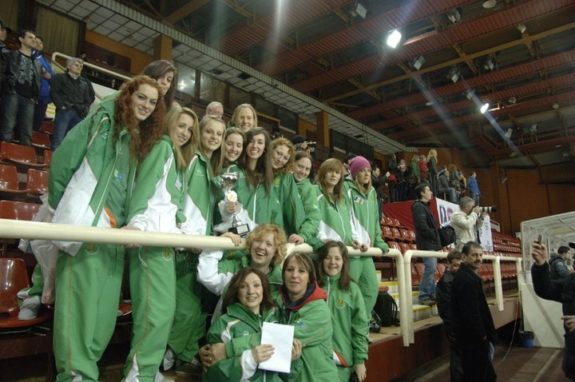
While none of the aforementioned affiliations are entirely perfect, they are all relatively successful. They possess means of showcasing the finest talents in the women’s game. Each has its own stars, and those same stars typically have held an international presence at some point in their careers.
Now imagine, if you will, that the USA, Canada, Finland, Sweden and Russia suddenly no longer have any ice rinks. None whatsoever. Not only would each of those women’s leagues probably cease to exist, but so would any men’s leagues, youth leagues, and any form of recreational ice hockey.
This is the case for ice hockey in Ireland.
The passion and the love for the game are indeed very much alive in Éire, one of the country’s many nicknames. This makes the situation all the more difficult to swallow with no place to play.
The Irish Ice Hockey Association
“At the present Ireland does not have an ice rink,” Sonya McEneaney told THW. McEneaney is the Female Development Officer of the Irish Ice Hockey Association. “Our only rink shut down in 2010, so unfortunately Ireland does not meet the IIHF’s minimum participation standards for World Qualifiers and Championships.”
The Dundalk Ice Dome was the first permanent ice arena in Ireland. After the rink opened in December 2006, a women’s club team was formed the following Spring. When the first club was established, interest in the sport from Irish women and girls quickly developed, and participation numbers grew accordingly. Eventually, the IIHA recognized a need to put a female development plan into place, which sprung forth a women’s national team for the country.
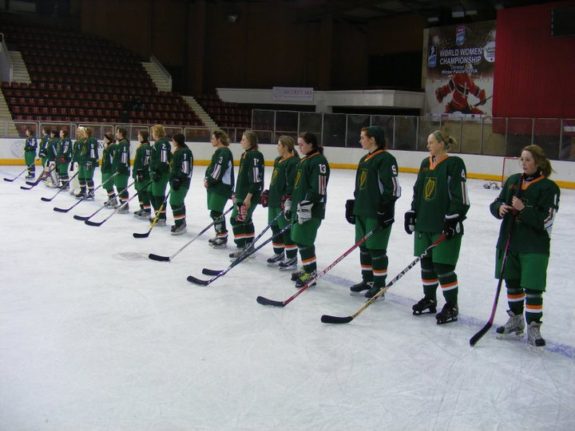
McEneaney served as team captain for Ireland’s first Women’s World Championship appearance in 2011, and was an alternate captain in 2012’s qualification tournament. Those are the only two IIHF tournaments that the Irish Women’s National Team have competed in thus far. Without a rink of their own, it is difficult to imagine that they will compete again very soon. McEneaney has taken it upon herself to ensure that interest does not wane.
“As Female Development Officer, I’m trying to keep the passion for ice hockey alive among the females whom we have left and our junior girls,” McEneaney explained. “We hold ‘fun days’ and practices on temporary Christmas ice rinks. Also, we avail of limited ice slots in Belfast in the United Kingdom. We are actually holding a girls event to celebrate the IIHF World Girls’ Ice Hockey weekend on the sixth of October.”
It Means a Great Deal to the Players
The interest in women’s ice hockey on the “Emerald Isle” is definitely real. Just ask Avril Ni Mhathuna, one of McEneaney’s teammates on both the 2011 and 2012 squads. The 5-foot-9, 30-year-old forward was very much like any Canadian or American youngster who has wanted to play the game. Both countries had a direct impact upon Ni Mhathuna as well.
“I grew up in a town on the west coast, Galway,” she explained. “There was one family on my street from Canada, with kids my age who had some hockey sticks. This was during the era of rollerblades and The Mighty Ducks, so naturally we played street hockey. We used some of their hockey sticks and some hurleys (a hurley is a stick in traditional Irish sports such as hurling and camogie).”
Ni Mhathuna went on to share, “My family moved away to another city, but I came back to Galway for University. There an inline hockey club had been established by the group from the street that I grew up on. I joined that university club and a city club, which competed in the national inline league.”
The First Tournament in 2011
The first IIHF tournament that Ireland competed in was the 2011 Women’s World Division V tournament held in Sofia, Bulgaria. The Irish squared-off against Poland, Spain, Bulgaria and Turkey. McEneaney was elected Ireland’s captain for the tournament, while the coaching staff at the helm held a number of camps and tryouts to determine which players made the inaugural team.
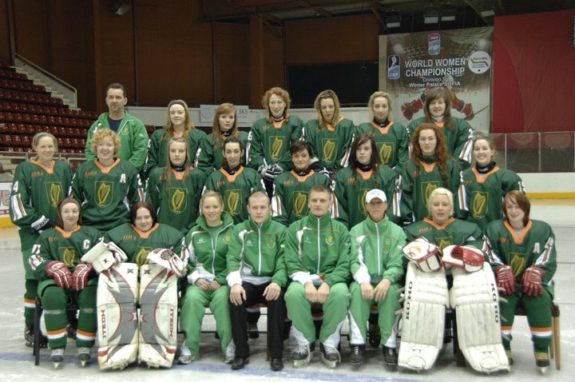
Ni Mhathuna was spotted while competing in an Irish national inline hockey competition in Kilkenny.
“I was approached by our national team coach, Vytautas Lukosevičius,” Ni Mhathuna recalled. “He shared that tryouts would be coming up for the Women’s National Ice Hockey Team, bearing in mind that I had never played on ice before – only on wheels. At this time seasonal ice rinks were being set up in cities around the country, and local inline teams would rent them after hours to play 3-on-3 shinny. I joined these sessions to get used to the ice. I went for tryouts and made it onto the panel – after lots of practicing hockey stops,” Ni Mhathuna laughed.
This first tournament did not go well for Ireland, but it was a learning experience nonetheless. The Irish lost all four of their contests, and failed to score a goal. They did however manage to keep close 3-0 scores against both Turkey and Bulgaria. Another win for the team was their goaltender, Seanna Conway, who despite allowing 18 goals in three games still posted a .901 save percentage – the third best at the tournament.
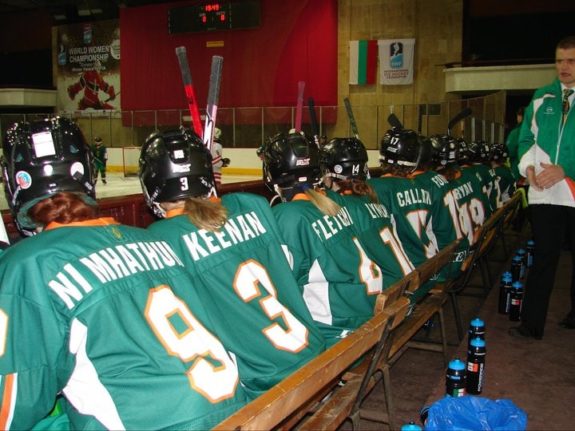
“I learned that persistence is key,” McEneaney explained quite earnestly. “I wasn’t playing hockey for very long before the tournaments, but despite my early struggles I continued to play and practice hard – eventually, discovering my love and passion for the sport.”
Ireland’s Growth in 2012
2012 would be Ireland’s final IIHF competition, and there were indeed some positive highlights that depicted growth. The Irish would take to the ice in the Division II-B qualification tournament held in Izmir, Turkey. The team played two games – one each against Turkey and Bulgaria.
In a 6-1 loss to Bulgaria on Dec. 8, Ireland’s Cherise McCaughley would tally the first goal in her country’s history. The very next day against Turkey, McEneaney would score a goal of her own with an assist from fellow defender Laura Lyons.
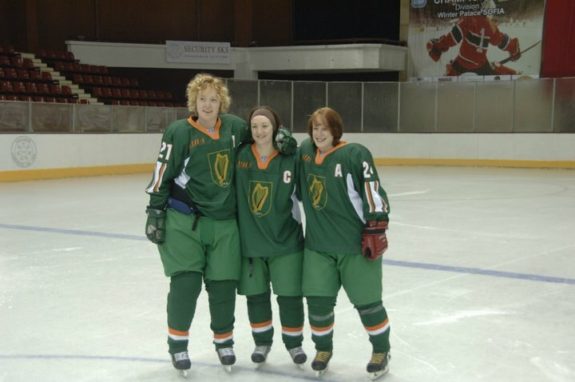
Despite the losses that Ireland experienced, Ni Mhathuna looks back on both tournaments in a most positive, heartfelt manner. After all – what athlete does not dream of the opportunity to represent her own country? There is a lot of emotion among the Irish that has nothing to do with statistics or standings.
“Irish people are very proud of bring Irish,” Ni Mhathuna stated. “Being able to pull on the Irish jersey to represent home is an incredible privilege. I find, in particular, people’s reaction of bafflement to the fact that ice hockey is even played in Ireland – a country with no ice rink – and that we have a national team that has represented at two world championship competitions. That reaction immediately turns to pride, support and eager curiosity. It brings me back to the moment of being on the ice in the green jersey with the national anthem of a team – who against the odds – turned up and played their hearts out.”
Irish Eyes Are Smiling on Women’s Hockey?
Someway, somehow, Ireland is looking to keep their women’s ice hockey hopes alive. That is where McEneaney’s role comes in especially. She is working diligently to prevent a flame from being extinguished, and she minds the embers most attentively.
Unlike North America or the European countries, there isn’t a women’s ice hockey league in Ireland, not even during the winter months.
“Unfortunately we don’t have a women’s league,” McEneaney shared. “However, we do have a women’s team that competes in the Cross Border Cup. The games are played out of the rink in Belfast, (the capital city of Northern Ireland). But again, training and practice time is extremely limited.”
THW asked McEneaney this question: What is something that you would want people in more traditional hockey countries like Canada or the USA to know about women’s hockey in Ireland?
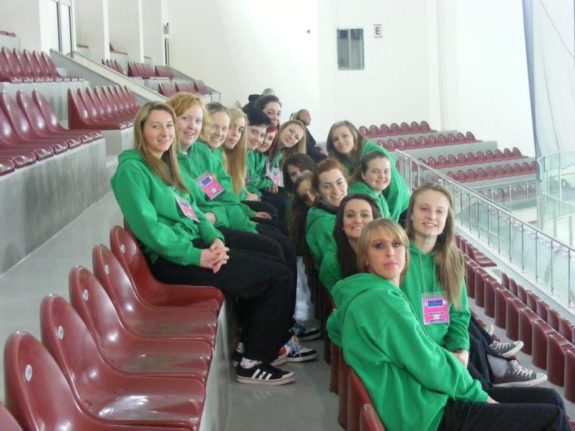
This was her response:
“I would like to highlight to these countries that we don’t have a rink and we desperately need one! It is extremely difficult and challenging to grow our sport without an adequate facility. Ice hockey is classed as a minority sport, and unfortunately other sports, such as Gaelic football and hurling -our national sports – take precedence.”
In the face of these challenges, McEneaney, her teammates, and the other Irish supporters of the women’s game wish to remain steadfast. But they could using a helping hand, especially from their hockey brothers and sisters in other countries. Even just getting the word out that there is a keen interest to have women’s ice hockey in Ireland can help make a difference.
“The Irish Ice Hockey Association is doing everything in its power to secure an ice facility,” McEneaney said strongly, “but there are many obstacles and hurdles in the way. If anyone is reading this and is thinking that they could help us in some way to achieve our goal of re-opening a rink in Ireland, then please do get in touch.”
If you would like to learn more about the Irish Ice Hockey Association, or feel inclined to help in some way, here is a link to their website: http://www.iiha.org/